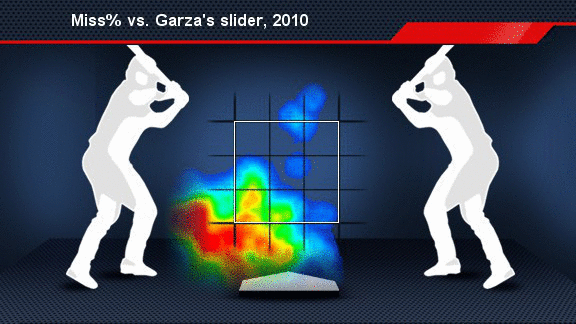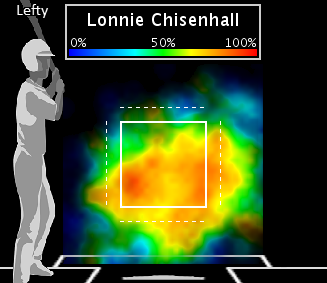Garza Brings Wicked Slider to Milwaukee
 Alec Dopp |
Alec Dopp |  Monday, January 27, 2014 at 9:55PM
Monday, January 27, 2014 at 9:55PM
After a few days of uncertainty, the Milwaukee Brewers officially announced their signing of free-agent starter Matt Garza Sunday afternoon, a deal that's reportedly worth a guaranteed $50 million over the next four years with a vesting option for the fifth year. Garza, who spent the first half of last season with the Cubs before being dealt to the Rangers, posted a combined 3.82 ERA and 1.24 WHIP over 24 starts in 2013 en route to a 1.4 bWAR, which was his lowest single-season wins above replacement total since 2007 -- back when he was still tossing for the Minnesota Twins as a mere 23-year-old up-and-comer.
Yet while Garza was largely a disappointment from a pure 'value' standpoint last season, his strongest asset as a starter actually become more lethal than ever before. The asset I am referring to is of course none other than his 'wipeout' slider, which has developed a reputation for being one of the best in baseball.
More Whiffs than Ever Before
 Since 2010, Garza's slider has progressively induced more swings and misses with each passing year. Posting a 38.3% miss rate with the offering four seasons ago is nothing to sneeze at, especially compared to the 30.1% league average that year. However, that number increased to 41.7% in 2011, stayed steady at 41.4% in 2012, and increased to an impressive 44.9% last season, which was the highest rate of any right-handed pitcher who tabbed at least 150 innings.
Since 2010, Garza's slider has progressively induced more swings and misses with each passing year. Posting a 38.3% miss rate with the offering four seasons ago is nothing to sneeze at, especially compared to the 30.1% league average that year. However, that number increased to 41.7% in 2011, stayed steady at 41.4% in 2012, and increased to an impressive 44.9% last season, which was the highest rate of any right-handed pitcher who tabbed at least 150 innings.
What makes these improvements somewhat perplexing is the fact that Garza has thrown the pitch in the strike more often with time. In 2010, his slider zone% stood at 38.5% and jumped to 43.4% the following season. By the end of 2012, Garza threw 44.6% of his sliders in the strike zone, and last season remained near that mark, placing 43.7%f of his wicked sliders in the zone. Typically, as pitchers throw more sliders in the zone, their miss% decreases, but Garza's slider seems to be bucking the trend in this respect.
Best in the League? Almost.
Now that we've got a good sense for how Garza's slider has improved in the last four seasons, it's time to see how he stacks up with the competition.
| P | K% | Miss% | SwStr% | InPl% | Chas% | |
|---|---|---|---|---|---|---|
| 1. Chris Sale (CWS) | 2,257 | 49.9% | 40.7% | 16.5% | 29.4% | 33.3% |
| 2. CC Sabathia (NYY) | 3,189 | 47.9% | 40.3% | 18.5% | 30.6% | 37.7% |
| 3. Clayton Kershaw (LAD) | 3,126 | 44.5% | 42.1% | 22.5% | 27.4% | 38.6% |
| 4. Francisco Liriano (PIT) | 3,409 | 44.3% | 42.8% | 22.3% | 27.5% | 41.9% |
| 5. Matt Garza (TEX) | 2,203 | 43.1% | 41.8% | 22.4% | 30.6% | 40.8% |
| 6. Justin Masterson (CLE) | 2,577 | 42.3% | 37.7% | 15.8% | 30.3% | 29.6% |
| 7. Carlos Marmol (LAD) | 2,647 | 40.4% | 37.5% | 16.2% | 28.1% | 32.1% |
| 8. C. J. Wilson (LAA) | 2,108 | 39.2% | 37.2% | 18.5% | 30.9% | 39.4% |
| 9. Mat Latos (CIN) | 3,205 | 38.0% | 40.7% | 21.5% | 32.4% | 41.4% |
| 10. Ervin Santana (KC) | 4,822 | 35.6% | 39.1% | 18.3% | 32.2% | 37.8% |
As we can see, Garza's slider has produced gaudy numbers across the board, ranking in the top ten of all pitchers in miss% (41.8%), swinging strike% (22.4%), chase% (40.8%), in play% (30.6%) and strikeout rate (43.1%) who've thrown at least 2,000 sliders since 2010.
Will a change in scenery affect Garza's slider next season with Milwaukee? Only time will tell. But for now, let's just appreciate how masterful the offering has been.
 Matt Garza,
Matt Garza,  Milwaukee Brewers,
Milwaukee Brewers,  free agency
free agency


